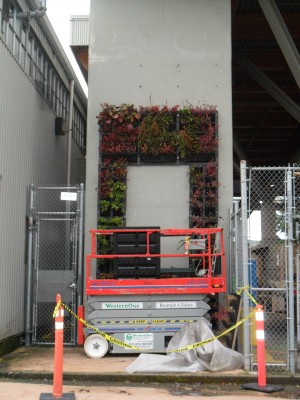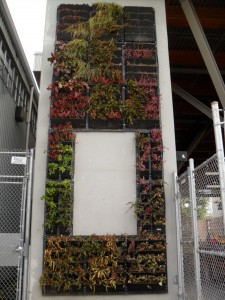Originally posted Posted on BCIT Update on March 23, 2014 by Life at BCIT Blogger Rosa Lin.
Incoming: more learning tools for Architectural Ecology! Installation is now complete for our new living wall, the grandest one yet. At 21 feet high and 7.5 feet wide, the ModuloGreen system paves a vertical visual path from a bustling trades area on the ground-level, up towards a soon-to-be rooftop feature: the Elevated Lab, our latest research base for living architecture.
Tucked just behind this cascade of inviting plants is the newly upgraded access stairwell leading to the Elevated Lab. The Elevated Lab will house several green roof learning plots, various living walls and facade systems, a rooftop classroom deck, a variety of monitoring equipment and a rainwater harvest system for irrigation. This living wall is the first Elevated Lab feature that we can see from the ground level, though the monitoring system and the LCD display are not yet ready at time of this writing.
The tall beauty is more than a just a looker. In addition to acting as a “sign” and bringing more lushness to the predominantly concrete-and-asphalt surrounds, the living wall will serve the same three major purposes as the rest of the Elevated Lab: demonstration, education, and research.
What about maintenance? In the first few months, the living wall will require more frequent care and observation until the plants establish their root system and “settle in.” Thereafter, maintenance can decrease to one interface per month. An in-line fertilizing function is built into the irrigation system: as the plants get watered they will also be fed nutrients, automatically and in the proper dosage!
Another unique fact about this living wall is that it is north-facing, while most other green walls in our city are installed on the south facade. North-facing living walls may have wider applications— since the north-facade does not compete with south-facing functions like day-lighting and solar energy harvest— and thus be worthy of further research. Shade-tolerant plants were specifically selected for this purpose.
So, what will we research about this living wall? Continue reading the next post!
P.S.: Here is a related blog post by BCIT media on the new living wall (picture).
You can also read the official introduction to the Elevated Lab by the Center for Architectural Ecology here.


Awesome job Living Wall team!